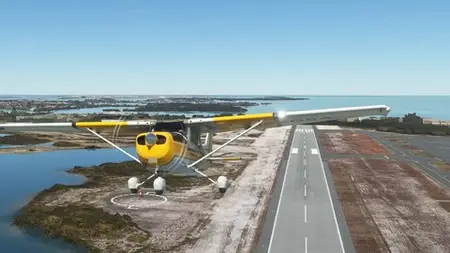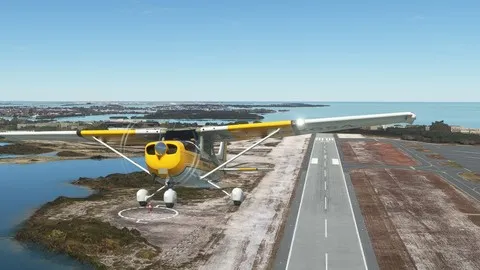How To Fly The Cessna 172 In Microsoft Flight Simulator
Published 9/2024
MP4 | Video: h264, 1920x1080 | Audio: AAC, 44.1 KHz
Language: English | Size: 3.53 GB | Duration: 1h 49m
Published 9/2024
MP4 | Video: h264, 1920x1080 | Audio: AAC, 44.1 KHz
Language: English | Size: 3.53 GB | Duration: 1h 49m
Learn the real-world procedures and checklists to fly the Cessna 172 in MSFS.
What you'll learn
Real-world checklist and procedures
Planning and setting up the flight
Important details for real-world pilots
Simulator-specific tips
G1000 vs. steam gauge 172; enhancement add-ons
Requirements
No Cessna 172 experience needed. However, you should have basic aircraft control skills.
We will not be covering flight planning, navigation, ATC, emergencies, autopilot ops, etc. The focus is on checklists and aircraft operating procedures.
Description
Welcome to our introductory course on flying the Cessna 172 Skyhawk in Microsoft Flight Simulator.If you want to use real-world procedures to fly the 172 as realistically as possible in your simulator, this is the course for you. You will benefit from this course whether you’re preparing for real-world flight lessons or flying your simulator as a hobby.It’s taught by a real-world flight instructor and flight sim expert with over 1000 hours of flight experience in the Skyhawk.What will I get from this course?After completing it, you will understand how to operate the Cessna 172 using real-life procedures and manuals.What skills should I have?You should have the basic skills to control an aircraft during taxi, takeoff, landing, etc. Basic flying techniques are not covered, since the focus is on procedures specific to the Cessna 172.What will you learn?Check out the syllabus tab for a full description of the course content. We'll highlight some key areas below:Real-world checklist and proceduresLearn how real-life pilots operate the aircraft, directly from the manuals published by Cessna.We will teach you how to find these manuals online (for free).We cover all normal checklists and procedures, including how to start the engine, runup, landing, and shutdown.As we go through each item on the checklist, we use clear markers to help you quickly locate each button, knob, or switch in the cockpit. We also discuss reasons why each checklist item is important.Planning and setting up the flightWe will fly a short, simple route from Arlington (AWO) to Skagit (BVS).It’s very easy to navigate visually along this route, so you don’t need any background in instrument navigation. You should be able to follow along even if you are a beginner.Important details for real-world pilotsWhen relevant, we point out differences between the MSFS Cessna 172 versus the real aircraft.We also discuss some differences between different variations of 172s you may encounter in real life. The version simulated in MSFS is like a modern "S model" Cessna 172. However, other 172s may have different engine types, flap settings, speed limitations, etc.Simulator-specific tipsYou will learn some simulator-specific skills like setting up fuel quantities and using keyboard shortcuts.Additional items:G1000: Learn the procedural differences in operating the G1000 (glass cockpit) version of the Cessna 172. You will learn how the differences in the electrical system and the need for redundancy create some new checklist steps versys the steam gauge version.Enhancement add-on: Learn how to install and use a free enhancement pack for the MSFS Cessna 172. It will give you features like realistic checklists, kneeboard charts, sun visors, and many other enhancements.Which kind of 172?We use a round dial (steam gauge) Cessna 172S which is built into Microsoft Flight Simulator by default.The startup procedure and before takeoff checklist for the G1000 (glass cockpit) variant are covered in the additional items section.For detailed G1000 procedures, we recommend viewing our G1000 Training Course (Intro).Who is it for?The course is made for real-world student pilots and enthusiasts who want to fly their simulated Cessna 172 as realistically as possibleWhat is not covered?Preflight inspection (such as the exterior walkaround before the Before Start Engine checklist)Flight planning (aside from basic route and altitude selection using SkyVector)Navigation proceduresATC or CTAF communicationsEmergency proceduresDetailed autopilot operationsIn-air leaning procedures (on-ground/taxi leaning is covered)Knowledge items unrelated to the flight, like aircraft limitations, performance speeds, weight and balance, etc.What if I use X-Plane or another simulator?While the recording uses MSFS, the information is still applicable for operating any simulated Cessna 172.Disclaimer: This course is not a substitute for in-person flight instruction with a qualified instructor. Procedures can differ between different variants and years of Cessna 172 production. Be sure to reference the Airplane Flight Manual (AFM) for your specific variant of Cessna 172 to ensure you are following the most correct, up-to-date procedures for your specific aircraft.
Overview
Section 1: Cessna 172 Intro
Lecture 1 Welcome
Lecture 2 How to find an official Cessna 172 checklist/manual
Lecture 3 Navigating the PIM
Section 2: Full flight tutorial
Lecture 4 Flight planning
Lecture 5 Sim Setup
Lecture 6 Before Start and Starting Engine
Lecture 7 Taxi
Lecture 8 Before Takeoff Checklist and Takeoff
Lecture 9 Climbout and Level Off
Lecture 10 Cruise
Lecture 11 Descent
Lecture 12 Landing
Lecture 13 Taxi In and Shutdown
Section 3: Startup and Runup in the G1000 C172
Lecture 14 G1000 Intro and Flight Setup
Lecture 15 Startup Procedures
Lecture 16 Before Takeoff Checklist (Runup)
Section 4: C172 Enhancement Pack
Lecture 17 How to install it
Lecture 18 Overview of features and test flight
Section 5: Conclusion
Lecture 19 Next steps
The course is made for real-world student pilots and enthusiasts who want to fly their simulated Cessna 172 as realistically as possible.



